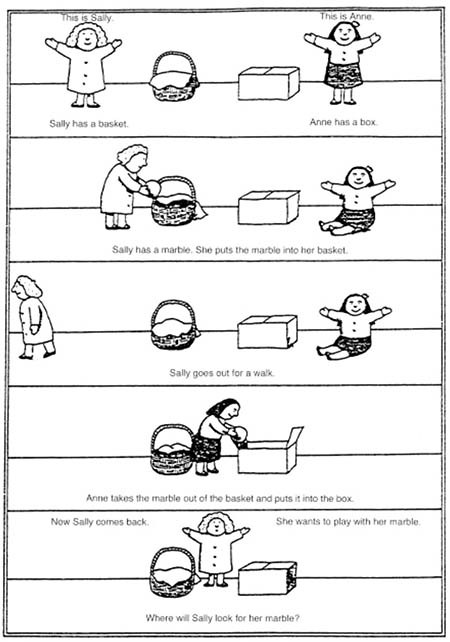The children in the video are doing a task called: false belief task. During the task a participant is told a story with the following outline:
A child has an item they want (for example chocolate) that is placed in a specific location (for example a red cupboard) they can see. The child then leaves the room (for example to go play outside). During this time, the item (chocolate) is taken by another person (for example, the mother needs some of the chocolate to make cake) and then put in a different place (green cupboard). Finally, the child comes back into the room (they are tired from playing outside and want the chocolate now).
After hearing the above story, the participant will be asked where the child from the story would go looking for the chocolate. Most adults and older children will know that the child from the story would think the chocolate is still in the original place (red cupboard) as they did not see it being moved to another place. However, the understanding that other people can have their own beliefs only develops as children get older.

Many researchers have tested this phenomenon with different versions of the task above (for example, stories with toys as visual aids, telling them to really think about it or with shorter stories). They all found that children at the age of 3 usually answer that the child will go looking for the item in the new place (green cupboard).
4-year-old children, however, will have the understanding that their own knowledge might be different to what other people know, and thus will answer from the perspective and with the knowledge of the child in the story.
This ability is called Theory of Mind. It is the awareness of, and the ability to guess, other people’s thoughts and feelings, as well as making sense of their behaviour and being able to predict it based on their thoughts and feelings.
Theory of Mind develops with age. Very young children only tend to think about themselves but as they get older, they also think about others and eventually how others think about themselves.
While it generally develops around this age range, some children might develop it slightly earlier. This might be the case in children who interact more with their parents who help their children to be aware of other people’s beliefs and feelings.
This ability is very important in the day-to-day life. However, some people might never fully develop this ability which can cause problems in their life as they will struggle to understand other people’s feelings, knowledge and intentions and therefore will find it difficult to anticipate other’s behaviour. They might also struggle to understand unwritten rules and social norms. This atypical development of Theory of Mind can be found in people with Autism or certain mental illnesses.
References
Lewis, C., Freeman, N. H., Kyriakidou, C., Maridaki‐Kassotaki, K., & Berridge, D. M. (1996). Social influences on false belief access: specific sibling influences or general apprenticeship?. Child development, 67(6), 2930-2947.
Perner, J., Leekam, S. R., & Wimmer, H. (1987). Three‐year‐olds’ difficulty with false belief: The case for a conceptual deficit. British journal of developmental psychology, 5(2), 125-137.
Lewis, C., Freeman, N. H., Kyriakidou, C., Maridaki‐Kassotaki, K., & Berridge, D. M. (1996). Social influences on false belief access: specific sibling influences or general apprenticeship?. Child development, 67(6), 2930-2947.
Sullivan, K., & Winner, E. (1993). Three-year-olds′ understanding of mental states: The influence of trickery. Journal of experimental child psychology, 56(2), 135-148.